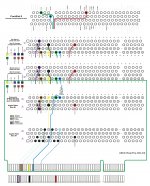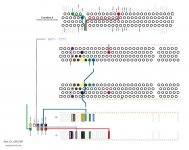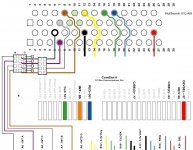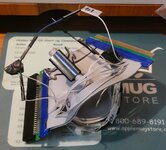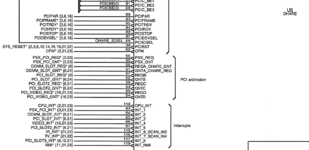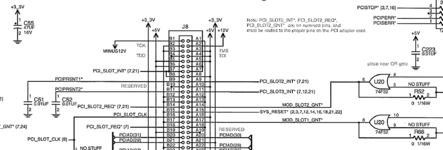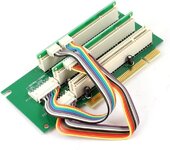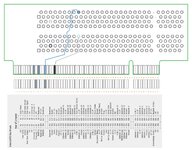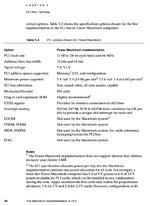Trash80toHP_Mini
NIGHT STALKER
View attachment 24449
The connector at the bottom has 194 pins, 97 on each side. The pins aren't numbered in silk screen, so for my purposes, I numbered them from left to right on the front. On the back, I did not flip the card over. Pretend you're looking through the board, oriented as above, and the back pins are left to right, 98 - 194. So pin 98 is opposite pin 1. Pin 194 is opposite pin 97, in my system.
Pins run: 1 - 42, 43 - 87, 88 - 97; 98 - 139, 140 - 184, 185 - 194
where commas are the slot notches.
I found the following:
Pin 114 Slot C interrupt
Pin 113 Slot A interrupt
Pin 17 Slot B interrupt
Pin 76 Slot A REQ
Pin 77 Slot B REQ
Pin 79 Slot C REQ
Pin 174 Slot A GNT
Pin 175 Slot B GNT
Pin 177 Slot C GNT
Pin 153 Slot A IDSEL, ADD 13
Pin 55 Slot B IDSEL, ADD 14
Pin 151 Slot C IDSEL, ADD 15
Wow, that pinout is nothing like any standard of which I'm aware. Is that implemented on a single connector on the logic board or abutted connectors?
Slot 1 = another connector on the Logic Board or ComSlot on the riser?Anyway for the first three above, I found a pin on the comm slot which connected to what ought to be the next pin in the sequence of interrupts, GNTs or REQs. I didn't check IDSEL. So I strongly suspect it's an independent PCI slot. Umax did some unnatural stuff on the S900, where the sold a combo U2 LVD SCSI card with 10/100 ethernet on board. It only worked in slot 1 of the S900 and there was an extra little connector at the end of the PCI slot to provide extra signals to support the ethernet portion. Then there was a hacked to the gills driver that added an OF script when made the ethernet portion appear as slot E, which is some kind of special legacy slot in the firmware or some such.
Slot E1 is the normal location of the CS2 EtherNet card. I imagine the OF script would be a system patch for the SCSI half of the card. I wonder how TattleTech reports the SCSI setup, if at all? A parallel might be the Futura II VidCard/EtherNet daughtercard combo which shared the same NuBus Slot ID?
Have you run TattleTech to see if the SCSI portion might be located at Slot D1? The PCI report might show D1 as available without having the card installed. D1 is a curious gap in the ID sequence of Alchemy. It's probably more likely that the SCSI implementation shares E1 though.
That extra connector has how many pins? ComSlot2 connector is shorted six connections of a PCI connector and a gaggle of connections are dedicated to the CS2 modem. So the second connector probably fleshes CS2 out so as to support the full PCI spec?But it wouldn't make any sense for the C600 to use a similar system because anybody's card might be installed in the comm slot. The E100 card, as it was called, was the only card that could use that extra connector in the S900.
Not even close. It's a standard PCI connector, but at least one reserved pins isn't, it's a direct connection to the REQ pin of Slot B1. INT A and INT C are connected to A5 which is +5V holding the coding high on Slot B1.Do the PM6400 and PM6500 use the same 194 pin connector for their riser cards?
Haven't worked on Slot A1 yet other than to successfully install a VidCard directly into the MoBo sans riser.
All RA Rackmount risers I've tested appear to function as slot A1, with one possible exception. Can't put my hands on it for testing, hopefully it will turn up and not be the same card as another I'm trying to re-locate in hopes of modifying it to Slot B1 function. If/when I can do that, I should be able to spec the TwinSlot riser for TAM and the other single slot riser limited Macs. After that I can start playing Slot C1 mix-n-match games.
When you have a chance, could you buzz the connections between connectors for Slots C1, B1 and A1 to identify which lines on C1 are unconnected to either of the other two. Fifteen drop out between A1 and B1. I'll post a table when I can sort a couple of things out. The dropouts should be located between A6/B6 and A19/B19. The only outlier will almost certainly be the REQ line at A26. Which "Reserved" line Apple intended (provided?) for that one on the logic board riser slot is the mystery.

